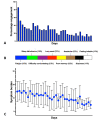A Digital Health Intervention for Concussion: Development and Clinical Feasibility Study
- PMID: 36724010
- PMCID: PMC9932878
- DOI: 10.2196/43557
A Digital Health Intervention for Concussion: Development and Clinical Feasibility Study
Abstract
Background: Concussion is a common condition that can lead to a constellation of symptoms that affect quality of life, social integration, and return to work. There are several evidence-based behavioral and psychological interventions that have been found to improve postconcussion symptom burden. However, these are not routinely delivered, and individuals receive limited support during their concussion recovery.
Objective: This study aimed to develop and test the feasibility of a digital health intervention using a systematic evidence-, theory-, and person-based approach.
Methods: This was a mixed methodology study involving a scoping review (n=21), behavioral analysis, and logic model to inform the intervention design and content. During development, the intervention was optimized with feedback from individuals who had experienced concussions (n=12) and health care professionals (n=11). The intervention was then offered to patients presenting to the emergency department with a concussion (n=50). Participants used the intervention freely and input symptom data as part of the program. A number of outcome measures were obtained, including participant engagement with the intervention, postconcussion symptom burden, and attitudes toward the intervention. A selection of participants (n=15) took part in in-depth qualitative interviews to understand their attitudes toward the intervention and how to improve it.
Results: Engagement with the intervention functionality was 90% (45/50) for the symptom diary, 62% (31/50) for sleep time setting, 56% (28/50) for the alcohol tracker, 48% (24/50) for exercise day setting, 34% (17/50) for the thought diary, and 32% (16/50) for the goal setter. Metrics indicated high levels of early engagement that trailed off throughout the course of the intervention, with an average daily completion rate of the symptom diary of 28.23% (494/1750). A quarter of the study participants (13/50, 26%) were classified as high engagers who interacted with all the functionalities within the intervention. Quantitative and qualitative feedback indicated a high level of usability and positive perception of the intervention. Daily symptom diaries (n=494) demonstrated a wide variation in individual participant symptom burden but a decline in average burden over time. For participants with Rivermead scores on completion of HeadOn, there was a strong positive correlation (r=0.86; P<.001) between their average daily HeadOn symptom diary score and their end-of-program Rivermead score. Insights from the interviews were then fed back into development to optimize the intervention and facilitate engagement.
Conclusions: Using this systematic approach, we developed a digital health intervention for individuals who have experienced a concussion that is designed to facilitate positive behavior change. Symptom data input as part of the intervention provided insights into postconcussion symptom burden and recovery trajectories.
Trial registration: ClinicalTrials.gov NCT05069948; https://clinicaltrials.gov/ct2/show/NCT05069948.
Keywords: behavior change; concussion; digital intervention; feasibility study.
©Christine d'Offay, Xin Yi Ng, Laura Alexander, Alison Grant, Julia Grahamslaw, Claudia Pagliari, Matthew J Reed, Alan Carson, David C Gillespie, Aimun A B Jamjoom. Originally published in JMIR Formative Research (https://formative.jmir.org), 01.02.2023.
Conflict of interest statement
Conflicts of Interest: CD, AABJ, and DCG are shareholders in HeadOn Health Ltd, which has an exclusive license for the HeadOn intellectual property from the University of Edinburgh. AC is a paid editor for JNNP, an unpaid president of FNDsociety and gave testimony in Court on a range of neuropsychiatric topics including TBI.
Figures



References
-
- Taylor CA, Bell JM, Breiding MJ, Xu L. Traumatic brain injury-related emergency department visits, hospitalizations, and deaths - United States, 2007 and 2013. MMWR Surveill Summ. 2017 Mar 17;66(9):1–16. doi: 10.15585/mmwr.ss6609a1. https://europepmc.org/abstract/MED/28301451 - DOI - PMC - PubMed
-
- Cassidy JD, Carroll LJ, Peloso PM, Borg J, von Holst H, Holm L, Kraus J, Coronado VG, WHO Collaborating Centre Task Force on Mild Traumatic Brain Injury Incidence, risk factors and prevention of mild traumatic brain injury: results of the WHO Collaborating Centre Task Force on Mild Traumatic Brain Injury. J Rehabil Med. 2004 Feb;(43 Suppl):28–60. doi: 10.1080/16501960410023732. https://www.medicaljournals.se/jrm/content/abstract/10.1080/165019604100... - DOI - DOI - PubMed
-
- Cnossen MC, van der Naalt J, Spikman JM, Nieboer D, Yue JK, Winkler EA, Manley GT, von Steinbuechel N, Polinder S, Steyerberg EW, Lingsma HF. Prediction of persistent post-concussion symptoms after mild traumatic brain injury. J Neurotrauma. 2018 Nov 15;35(22):2691–8. doi: 10.1089/neu.2017.5486. - DOI - PubMed
-
- McMahon P, Hricik A, Yue JK, Puccio AM, Inoue T, Lingsma HF, Beers SR, Gordon WA, Valadka AB, Manley GT, Okonkwo DO, TRACK-TBI Investigators Symptomatology and functional outcome in mild traumatic brain injury: results from the prospective TRACK-TBI study. J Neurotrauma. 2014 Jan 01;31(1):26–33. doi: 10.1089/neu.2013.2984. https://europepmc.org/abstract/MED/23952719 - DOI - PMC - PubMed
Associated data
LinkOut - more resources
Full Text Sources
Medical

